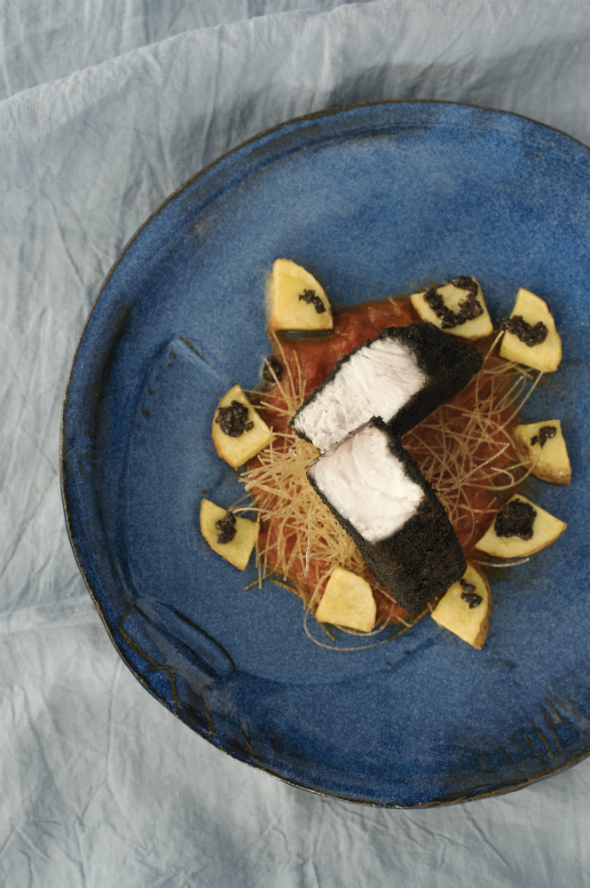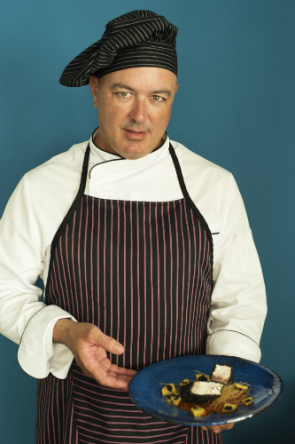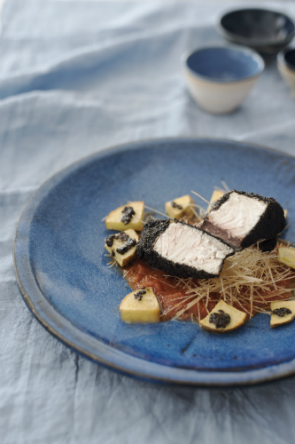800 gr of Medregal lemon fish in pieces
250 c.c. home made tomato sauce
2/3 potatoes, chopped up
200 c.c. extra virgin olive oil
300 gr bread crumbs
100 Ccc white wine
15 gr squid ink
50 gr rice noodles
2 egg whites
b) Preparation of the crust
Make a paste with the breadcrumbs, white wine and squid ink.
Spread onto paper.
Dehydrate and then grate.
Season the pieces of medregal fish, and put egg white over it.
Pour breadcrumbs over the Medregal fish with the black grated bread prepared earlier.
c) Preparation of the potatoes
Pour olive oil onto the potatoes and place them on a very low heat for around 35 minutes.
d) Preparation of the tomato sauce
The tomatoes must be perfectly ripe.
Stir-fry the onion, add the tomatoes, sautée for a few minutes, then blend.
Place the tomato sauce on a plate.
Put the fried rice noodles over the sauce.
Next, place the black crusty breaded medregal fish onto the dish.
Place the potatoes around the side with a touch of black truffle.

This is how Chef Nelson describes his recipe:
"I am presenting this 'Medregal in black crust' recipe because the fish comes from waters around our island, perhaps a little less known than sama, sea bass and Canarian hake, but just as nice and tasty.
Medregal is a fish that lives both on the sea bed and up on the surface. There are three varieties; lemon, pink and black. It is a reddy, and somewhat greasy meaty in texture. It has high levels of omega 3 and 6. It is a fish that lends itself really well to marinade, or in typical Canarian fish broth".
"At Restaurante Nelson we do seafood cuisine. In the Canary larder we have a wide range of fish, and some seafoods from different areas and sea depths. With different cooking methods we can do wonders with such quality products. In our à la carte menu we offer different varieties of fish and seafood, depending on the time of the year. With the deep fish we offer fula, Canarian hake, romerete, king crab and camarón soldado.
Our range of coastal fish depends again on the time of year and if weather permits, sardines, red mullet, bocinegro, viejas, medregal, pampano fish..."



Our 3rd ‘Dish-enhancing’ secret ingredient
The tomato from the southeast of Gran Canaria is a high quality crop, and has enjoyed a great tradition on the island, as has the tomato from La Aldea, a farming region that produces a range of different varieties that are exported all around Europe.
Yet tomato cultivation is much more that a mere ingredient in kitchens around the island. There is a long, long story behind its farming. It is a story of overcoming adversity and hard work, related here in detail at Pellagofio Digital Magazine.